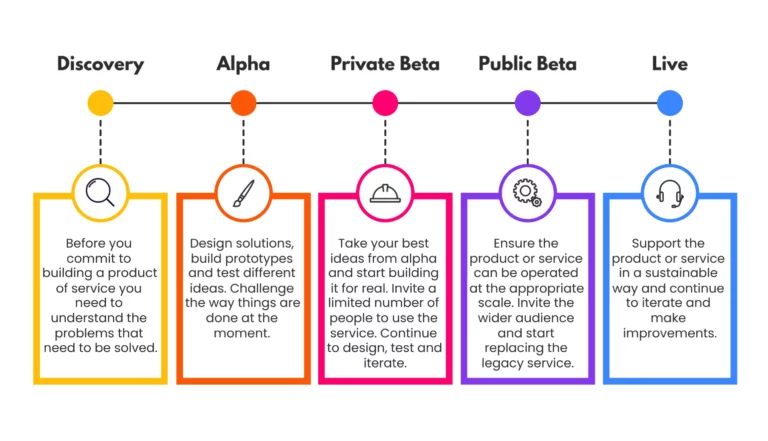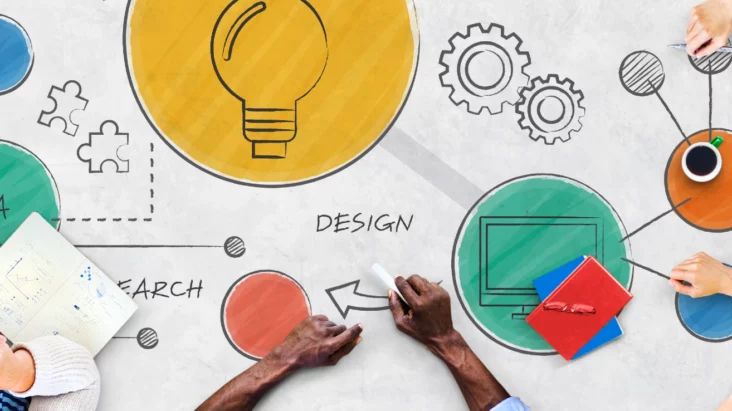In brief:
Welcome to this detailed exploration of the alpha prototyping phase in product development, a crucial stage often overlooked despite its importance. This guide will unpack the alpha phase’s significance, illustrating how it can make or break a product’s success. Drawing lessons from industry heavyweights such as Gmail, Slack, Spotify, and Airbnb, we will highlight how direct user feedback and rigorous testing during the alpha phase led to their triumphs. If you’re an entrepreneur, product developer, or project manager, read on to understand how embracing the alpha phase can substantially heighten your chances of launching a successful product.
Table of content:
The Alpha Phase: A Crucial Step in Product Development
Embracing Changes and Challenges: The Alpha Phase Uncovered
The alpha phase is a critical stage in the product development cycle, often considered the first significant milestone in bringing a new product to life. It occurs after the initial planning and design stages, serving as the launching pad for real-world testing and refinement.
In the alpha phase, the product is still in its early form, often with limited functionalities and features. This version of the product is typically not ready for the public but is functional enough to be tested internally or by a select group of users. The primary goal is to identify any bugs, glitches, or potential improvements that may not have been obvious during the design phase.
One of the distinct characteristics of the alpha phase is its focus on experimentation and learning. It is during this phase that different solutions and approaches are tested, with the aim to validate assumptions made during the planning stages. This involves a lot of trial and error, with teams quickly iterating on their ideas based on the feedback they receive.
Successful completion of the alpha phase sets the stage for the beta phase, where the product is exposed to a larger audience for further testing and refinement. However, the alpha phase is not just a stepping stone – it’s a vital part of the journey towards creating a successful product. It’s the phase where major issues can be caught early, saving time and resources down the line.
In essence, the alpha phase is all about turning ideas into reality and refining them until they’re ready to be shared with the world. It’s about learning, adapting, and improving – all crucial elements in the creation of a successful product.
Navigating the Product Development Journey: Discovery, Alpha, Beta, and Live

A Deeper Dive into Each Phase of the Product Development Journey
The journey of product development is typically segmented into several key phases, each with its unique objectives and outcomes. Understanding the differences between these stages – Discovery, Alpha, Beta, and Live – can provide valuable insights into the product development process.
Discovery Phase:
This is the initial stage where ideas are generated, and market research is conducted. The primary objective is to understand the problem that needs solving, identify the target audience, and determine the potential value of the solution. It’s all about exploring possibilities and setting the direction for the product.
Alpha Phase:
This is where the product begins to take shape. In the alpha phase, a preliminary version of the product is developed and tested internally or by a small group of users. The aim is to identify bugs, glitches, and areas for improvement. It’s a phase of experimentation, learning, and refinement. The feedback gathered during this phase helps fine-tune the product and validate the initial assumptions made during the discovery phase.
Beta Phase:
Following the alpha phase, the product moves into the beta phase, where it is exposed to a larger audience for further testing and refinement. The product is nearly complete at this stage, but the feedback from beta users helps iron out any remaining issues and improve the user experience. This phase provides valuable insights into how the product will perform in the real world.
Live Phase:
This is the final stage where the product is launched and made available to the public. The focus shifts from development to maintenance, with ongoing efforts to monitor the product’s performance, address user feedback, and roll out updates as necessary. It’s a phase of growth, optimisation, and continuous improvement.
Each of these stages plays a critical role in the product development journey. While they differ in their objectives and activities, they are all interconnected, with the outcomes of one phase feeding into the next. By understanding these distinctions, teams can better navigate the product development process and set their products up for success.
The Alpha Prototyping Phase: Why It's More Than Just a Step in the Process
Harnessing the Power of the Alpha Phase for Successful Product Development
The alpha phase, while often overlooked, holds immense importance in the product development journey. Its relevance stems from several key factors that directly influence the success of the final product.
Risk Mitigation: One of the primary roles of the alpha phase is to test the riskiest assumptions about the product. By pinpointing and addressing these risks early on, teams can prevent costly and time-consuming changes later in the development process.
User-Centric Refinement: The alpha phase provides an opportunity to understand the user’s perspective better. Through testing and feedback, teams can refine the product to meet user needs more effectively, improving the overall user experience and increasing the chances of product adoption.
Validation of Concepts: The alpha phase serves as a reality-check for the envisioned product. It allows teams to validate whether the product works as expected and if it solves the problem it was designed to address. This validation is crucial in deciding the direction of further development.
Efficient Resource Allocation: The insights gathered during the alpha phase can significantly impact resource allocation. Understanding what works and what doesn’t enables teams to direct their efforts and resources more efficiently, contributing to a more streamlined and effective development process.
Collaboration and Relationship Building: The alpha phase also fosters collaboration and relationship building among the team and with stakeholders. It encourages open communication and collective problem-solving, leading to a more cohesive and aligned team.
In essence, the alpha phase is a potential game-changer in product development. It’s not just about identifying bugs or testing features; it’s about validating assumptions, understanding users, managing resources, and fostering collaboration. It’s an opportunity to learn and improve, making it an invaluable part of creating a successful product.
The three Benefits of the Alpha Phase
The Power of Early Testing: Unleashing the Potential of the Alpha Phase
The Alpha phase in product development provides numerous benefits that contribute to the overall success of the product. Here are some key advantages:
User Feedback as a Catalyst for Improvement
During the alpha phase, direct user feedback serves as an invaluable tool for improvement. This feedback, often collected through alpha testing, provides detailed insights into how users interact with the product, what they like, and where they face challenges12. As a result, the development team can use this feedback to fine-tune the product’s features and functionalities, aligning the product more closely with user needs and preferences. This iterative process of feedback and improvement ensures that the final product is not just functional but also resonates with its target audience3.
Enhancing Team Communication
The alpha phase plays a pivotal role in fostering effective communication within the development team. As the team collaborates to identify and rectify issues, they develop a shared understanding of the product, its capabilities, and potential challenges. This collaborative environment not only strengthens the team’s communication dynamics but also ensures that everyone is aligned towards a common goal – creating a successful product.
Refining for a Successful Release
Detecting security vulnerabilities early in the development process is less costly than fixing security breaches after they’ve occurred. By catching potential security issues early, DevSecOps can save an organisation significant amounts in potential breach costs.
The Power of User Feedback in the Alpha Phase
Harnessing User Insights for Targeted Product Evolution
Direct user feedback is the compass that guides product development during the alpha phase. It serves as a reality check, revealing how real users interact with the product and offering insights into their needs, preferences, and challenges.
Identifying Pain Points:
Users are the best critics. They can quickly point out the areas where they struggle with the product. These pain points might not be obvious to the development team but could significantly impact the user experience. Addressing these issues early on can lead to a more user-friendly product.
Validating Assumptions:
The alpha phase is all about testing assumptions. Direct user feedback helps validate whether the team’s assumptions about user behaviour and preferences hold true in real-world scenarios. This validation can steer the product in the right direction and prevent costly missteps down the line.
Prioritising Features:
Not all features are equally important to users. Direct user feedback can help identify which features are most valuable to them. Prioritising these features can ensure that the team focuses its efforts where they will have the most significant impact.
Improving Usability:
Users can provide practical insights into the product’s usability. They can suggest improvements or enhancements that the team might not have considered. These suggestions can improve the product’s usability and overall appeal.
Building Relationships:
Seeking direct user feedback during the alpha phase also helps build relationships with users. It shows users that their opinions matter and that the team is committed to meeting their needs. This relationship-building can foster a sense of community around the product and turn users into loyal advocates.
In essence, direct user feedback during the alpha phase is a powerful tool for improving the product. It offers an unfiltered view of the product’s strengths and weaknesses, guiding the team in refining and enhancing the product to better serve its users.
Alpha Phase Success Stories: Real-Life Examples
Key Takeaways from Successful Alpha Testing Phases
1. Gmail:
Google’s popular email service, Gmail, is a classic example of a product that greatly benefited from an extended alpha phase. Initially, in 2004, Gmail was launched as an invitation-only alpha release to test its unique features like 1GB storage and threaded conversations. The feedback received during this phase led to significant improvements and new features, such as the powerful search function, which have since become defining features of Gmail.
2. Slack:
Before becoming a widely-used team collaboration tool, Slack underwent an extensive alpha testing phase within the company itself. The development team used the product for their internal communications, which allowed them to identify bugs, improve features, and enhance user experience in real-time. This internal alpha phase helped shape Slack into the highly efficient communication platform it is today.
3. Spotify:
The popular music streaming app, Spotify, also had a beneficial alpha phase. Initially launched for a limited number of users, the app underwent several changes based on user feedback and technical tests. The insights gained during the alpha phase were instrumental in refining Spotify’s recommendation algorithm, which is now one of its most loved features.
4. Airbnb:
The global home-sharing platform, Airbnb, also owes much of its success to an effective alpha phase. The founders initially launched the website for a limited audience and used the platform themselves. This hands-on approach allowed them to understand the user experience better, leading to significant improvements in the platform’s design and functionality.
These examples highlight the crucial role of the alpha phase in shaping successful products. It provides a valuable opportunity for teams to test their ideas, gain insights, and make necessary refinements, ultimately leading to a product that resonates with its intended users.
In conclusion:
In conclusion, the alpha prototyping phase is a crucial juncture in the journey of product development. It’s the stage that provides the first real connection between your team’s vision and the actual user experience. Embracing the alpha phase and taking on board user feedback can significantly enhance the functionality, usability, and overall success of your product. It’s not merely a phase to pass through, but an opportunity to learn, iterate, and refine, ensuring that your product is moulded by genuine user insights and needs. Don’t rush through it, but instead seize the chance to make your product the best it can be. Remember, patience and diligence during the alpha phase can be the key to unlocking your product’s full potential.








